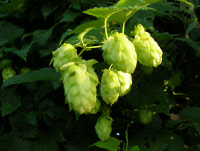Description
Vigorous 20′ tall climber bearing papery cones, green turning straw colored from August to October.
climber bearing papery cones, green turning straw colored
Vigorous 20′ tall climber bearing papery cones, green turning straw colored from August to October.
“…the berries are the thing – pewter in color, with a texture like those Fourth of July sparklers of childhood memory, they have a delicious fragrance.” Allen Lacy.
Size: 9’ x 10’
Care: sun in any soil
Native: Canada to Southeastern U.S. No pruning needed but can be pruned at any time of year, if desired.
Wildlife Value: Berries relished by chickadees, red-bellied woodpeckers, swallows, Titmouse, catbirds, bluebirds, Northern flicker & yellow-rumped warblers. Bayberry thickets also provide nesting sites for songbirds, offering excellent protection from predators.
Size: Fragrant leaves used for potpourri, abundant berries used to make candles. Good road-side plant, salt tolerant.
Probably 1st collected for gardens by John Bartram (1699-1776). Offered for sale in Bartram Garden’s 1783 Broadside, America’s 1st plant catalog. In 1800’s considered “very ornamental in the shrubbery.”
**LISTED AS OUT OF STOCK BECAUSE WE DO NOT SHIP THIS ITEM. IT IS AVAILABLE FOR PURCHASE AT OUR RETAIL LOCATION.
Powder-blue flowers of terminal clusters in early summer; feathery, thin,”threadleaf” foliage turns caution-sign yellow in fall.
Size: 2-3’ x 2-3’
Care: sun to part shade in moist well-drained soil
Native: Central-So, US
Wildlife Value: attracts butterflies & bees
Awards: Plant of Merit, Pennsylvania Horticultural Society Gold Medal
Collected in 1940 in Yell County Arkansas along a stream 3 miles west of Birta.
OUT OF STOCK
Outfacing, white, waxy cup-shaped flowers resembling single roses in late winter, evergreen leaves.
Size: 12-20” x 12”
Care: part shade in moist well-drained soil
Native: rocky places in Europe
Awards: Received Royal Horticultural Society Award of Merit.
The name Helleborus is Greek from hellein meaning “to kill” and bora meaning “food” referring to the plant’s poisonous qualities if placed in food. This species is ancient – known as long ago as 300 BC in Greece where it “purged and cured the mad or melancholicke daughters of Praetus with the roots thereof.” (Parkinson, 1629) Grown in the Eichstätt Garden, the garden of Johann Konrad von Gemmingen, prince bishop of Eichstätt in Bavaria, c. 1600. In Middle Ages petals thrown on floor to drive out evil and ward off power of witches. English herbalist John Gerard (1545-1612) strangely recommended it for curing poisoned animals. Sorcerers made themselves invisible by tossing the powdered plant in the air.
OUT OF STOCK
Sprays of large, single warming yellow daisies, blushed with apricot top a bushy mound of light green leaves, blooms late-summer to late-fall
Size: 1-2’ x 2-3’ and spreading
Care: Full sun to part shade, tolerates normal, sandy or clay soil
Wildlife Value: Attracts bees, butterflies and birds. Deer resistant.
One of the rubellum hybrids, Hybridized in the 1930’s

